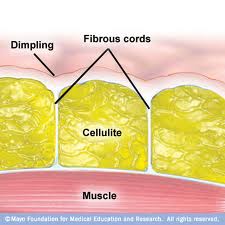Cellulite remains a challenging aesthetic problem. While it is fairly well understood what comprises it anatomically, there remains no concensus on its etiology and ideal treatment. New technologies are emerging, however, that have begun to show improved and sustained results. Given these promising improvements in cellulite treatment, it is relevant to review what we know about this common aesthetic deformity and the cadry of treatment options available to treat it.

The earliest forms of cellulite treatment where cosmeceutical, the application of topical drugs and herbs applied to the skin. These have included a variety of agents including derivatives of the aminophylline family, caffeine, yohimbine, carnitine and a variety of herbal extracts. Improvements from this approach have been largely anectodal and few if any scientific studies can show any consistent improvement in the appearance of cellulite.
Mesotherapy injections are often touted for cellulite treatment. They became more popular in the ‘lipodissolve’ craze from a few years ago. Using primarily phosphatidylcholine and deoxycholic acid formulations, these detergents primarily work on breaking down fat cell walls. They are more proven to have a fat reduction effect, mild as it may be, than they are at improving the overlying skin irregularities.
Endermologie has been around for over 15 years and is FDA approved for body contouring and cellulite reduction. It is essentially a suction massage approach applied manually through a roller-type device. Studies have shown some skin contour improvement that to be maintained requires regular maintenance treatments.
Carbon dioxide therapy is the instillation of a gas under the skin with low pressure infusion. This purportedly breaks the septae and stimulates collagen production in the skin to help even it out. There has been no conclusive and reproduced studies that have documented this effect.
UltraShape is a body contouring device that uses pulsed focused ultrasound energy for fat cell destruction by cavitation. While it has some fat reduction and body shaping effects, it is not approved for cellulite treatment in the U.S.
Ultherapy is another form of focused ultrasound that is used in the face for lifting sagging tissues. It is FDA cleared for eyebrow lifts and forehead rejuvenation. It is also being studies for cellulite treatment but these studies are ongoing and not yet available for review.
Liposonix is a high-intensity focused ultrasound device that is FDA cleared for non-invasive waist circumference reduction. It has no proven effect in cellulite reduction.
TriActive is an FDA cleared device for cellulite reduction that combines differing treatment methods as the name implies. It uses an 808nm infrared diode laser, cooling and suction massage.
VelaSmooth is another FDA cleared device for cellulite. It uses radiofrequency, infrared light and suction as its multimodality treatment method.
SmoothShape is also FDA cleared for cellulite. It uses a dual wavelength laser combined with suction massage.
Subcision is a limited surgical technique using an 18 gauge needle under local anesthesia. The objective is to release the septal bands by percutaneous severing of them in the depth of an indentation. It ahs failed to show consistent improvement.
Laser-assisted liposuction is an FDA-approved device for fat reduction but not cellulite. It is well known that fat reduction can even make the appearance of cellulite worse if not done judiciously. Thus Smartlipo and other laser liposuction devices should not be used primarily for cellulite reduction.
Cellulaze is the newest FDA cleared device in 2012 specifically for the improvement of cellulite. It uses a 1440nm pulsed laser with a side-firing fiber. Based on how it is angled, it can be used to release the fibrous septal bands, liquefy fat (no suctioning) and apply heat to the underside of the skin for collagen stimulation. Besides the unique delivery method, it is designed to be a single treatment.
While there are numerous available cellulite treatments methods, the most effective ones are device or energy-driven. Amongst such devices, most provide temporary improvement and require multiple treatments for maintenance. Only the newset device, Cellulaze, offers a single treatment with a lasting result.
Dr. Barry Eppley
Indianapolis, Indiana


